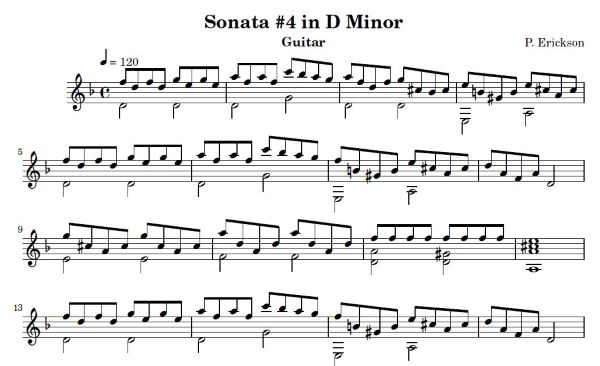Understanding and Using Guitar Tab Sheet Music
Understanding and Using Guitar Tab Sheet Music
An important step to mastering an instrument is to learn how to read sheet music. When you can read music, you open your horizons and can start to try a wider range of compositions. The guitar is no expectation. When you start to understand guitar tab sheet music, you’ll become a better player. Take a look at what you need to know so you can start using sheet music to its full potential.
What Is Guitar Tab Sheet Music?
To start, learn about the basics. Guitar tab sheet music, also known as tablature or tabs, is a simplified notation system specifically designed for guitarists. The guitar fretboard is represented visually, so you have clear indications of which strings and frets to play for each piece of music.
Is It Different Than Other Sheet Music?
A guitar tab is a bit different from standard sheet music. Most sheet music uses staff lines and musical symbols to indicate notes and other elements. Guitar tabs use a system of numbers, lines and symbols to represent the guitar strings and frets. Each string is represented by a horizontal line, and numbers are placed on the lines to indicate the fret numbers to be played. The lowest string is represented at the bottom, while the highest string is at the top.
The Benefits of Using Guitar Tab Sheet Music
So why are tabulations sometimes used in place of regular sheet music? The answer has to do with making things easier for people learning to play guitar. Guitar tab sheet music provides a straightforward and intuitive way for guitarists to learn and play songs without having to read traditional sheet music. For beginners who don’t have a lot of knowledge of sheet music or music notation, it’s still easy to quickly learn a song with a tabulation. Because the same notes can usually be played on different strings by using different frets, tabs take the guesswork out of choosing the best option.
Learning Placement
With tabs, guitarists get to focus more on their finger positions as they learn how to play. This reduces the need to understand notes as extensively as a player would need to if they were reading regular sheet music. Guitar tab sheet music can also be helpful for more knowledgeable players who need help with finger placement on a tricky or complicated song.
New players also get a chance to develop better muscle memory when they use guitar tab sheet music. You can train your hands to be in the right position for certain notes, improving your confidence and technique.
Pace Your Learning
With guitar tabs, you can learn at your own pace and easily break down a song into manageable sections. Tabs allow you to repeat and practice specific parts until you’ve mastered them before moving on to the next section. This flexibility enables you to test your abilities as you need and set your own goals.
It’s important to note that guitar tab sheet music does not provide information about rhythm, timing, or note duration as traditional sheet music does. However, it can be supplemented with additional markings, such as horizontal lines to indicate the length of notes or symbols for specific techniques like slides, bends, and hammer-ons.
Things to Consider When Using Guitar Tab Sheet Music
Guitar tabs are popular because they make it easier for people learning to play guitar, but there are some things to be mindful of. Anyone who wants to become a well-rounded guitar player should consider ways to make up for a few shortcomings that come with this tool.
Other Information About the Composition
Since guitar tab sheet music focuses on visual representations of your hand placement, it is missing some of the other notations often found on standard sheet music. While the tabulation will help with your hand placement, it does not have information about rhythm, note duration, dynamics and articulation. All of these are critical elements needed to play a piece of music correctly, so you may need a second learning aid when using a tabulation. Try playing the tabulation along with a recording to get the timing and rhythm correct.
Better for Simpler Pieces
Because of the lack of accompanying musical information, guitar tab sheet music is typically better for easier compositions. It’s used for simpler songs, riffs and melodies. If a song has complex chord progressions, intricate fingerpicking patterns or elaborate solos, tabs may not fully capture the subtleties and nuances needed to play the piece accurately.
Lack of Transposition
Since guitar tab sheet music tells you how to play a piece of music based on your finger position on the strings and fretboards, you’ll learn the song in the exact key and range presented in the tabulation. Every movement is meant to give you a specific note, but it’s not easy to figure out how to change, or transpose, the notes if you want to raise or lower the key of the song. This is where traditional sheet music can be helpful.
Limited Musical Education
While every person who picks up an instrument doesn’t have hopes of being the greatest composer, it is nice to be able to learn a bit of music theory as you learn to play your guitar. Guitar tab sheet music is great for learning to play specific and simple songs, however, it can be hard to get a deeper understanding of how to play guitar. You may have a harder time picking up notes and understanding how to get the right tones from your guitar if you only use tabs.
Explore Guitar Tab Sheet Music and Grow Your Skills
Becoming comfortable with a new instrument won’t happen overnight, but using guitar tabulations as a tool in your learning can help. While they may not serve every function in your musical education, they are great for learning how to place your hands on the instrument and understanding how to work the fretboard to learn easy songs.








